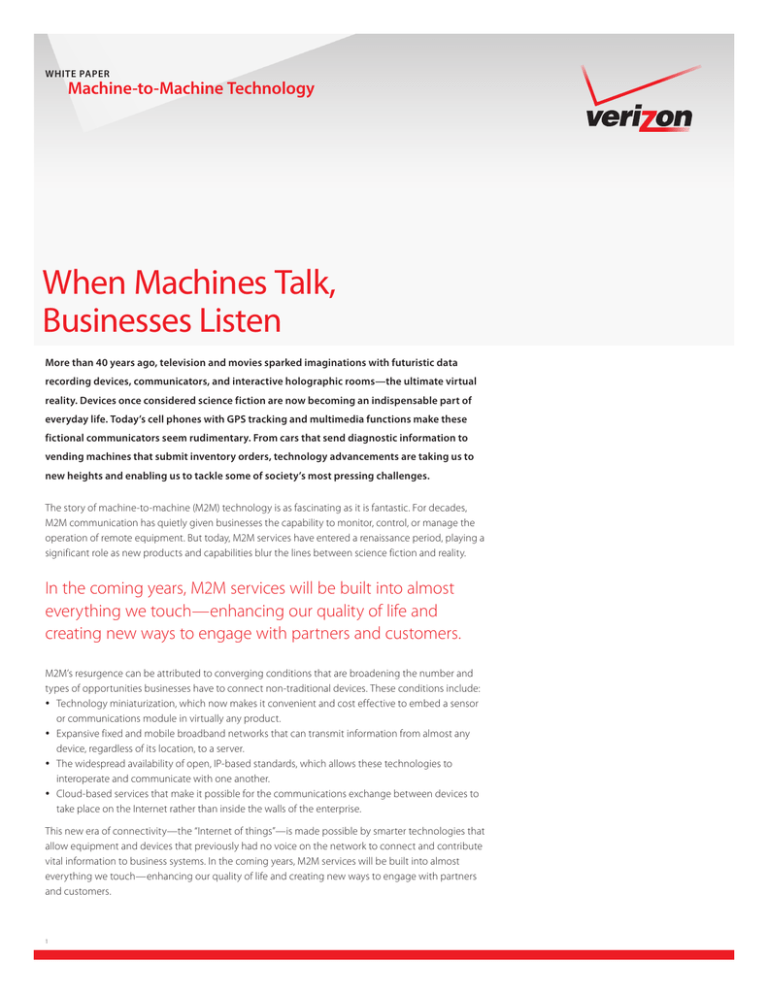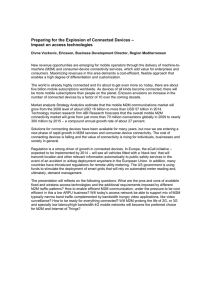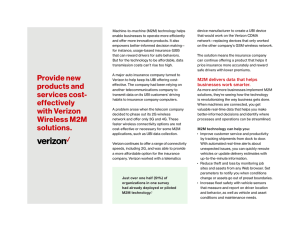
WHITE PAPER
Machine-to-Machine Technology
When Machines Talk,
Businesses Listen
More than 40 years ago, television and movies sparked imaginations with futuristic data
recording devices, communicators, and interactive holographic rooms—the ultimate virtual
reality. Devices once considered science fiction are now becoming an indispensable part of
everyday life. Today’s cell phones with GPS tracking and multimedia functions make these
fictional communicators seem rudimentary. From cars that send diagnostic information to
vending machines that submit inventory orders, technology advancements are taking us to
new heights and enabling us to tackle some of society’s most pressing challenges.
The story of machine-to-machine (M2M) technology is as fascinating as it is fantastic. For decades,
M2M communication has quietly given businesses the capability to monitor, control, or manage the
operation of remote equipment. But today, M2M services have entered a renaissance period, playing a
significant role as new products and capabilities blur the lines between science fiction and reality.
In the coming years, M2M services will be built into almost
everything we touch—enhancing our quality of life and
creating new ways to engage with partners and customers.
M2M’s resurgence can be attributed to converging conditions that are broadening the number and
types of opportunities businesses have to connect non-traditional devices. These conditions include:
• Technology miniaturization, which now makes it convenient and cost effective to embed a sensor
or communications module in virtually any product.
• Expansive fixed and mobile broadband networks that can transmit information from almost any
device, regardless of its location, to a server.
• The widespread availability of open, IP-based standards, which allows these technologies to
interoperate and communicate with one another.
• Cloud-based services that make it possible for the communications exchange between devices to
take place on the Internet rather than inside the walls of the enterprise.
This new era of connectivity—the “Internet of things”—is made possible by smarter technologies that
allow equipment and devices that previously had no voice on the network to connect and contribute
vital information to business systems. In the coming years, M2M services will be built into almost
everything we touch—enhancing our quality of life and creating new ways to engage with partners
and customers.
1
When Machines Talk, Businesses Listen
The Connected Consumer
The consumer market is ready for M2M services. Consumers have demonstrated their demand for
smartphones precisely because the devices have been built with sensors to capture information from
the outside world. Smartphone processors are capable of personalizing that information and using
programs to share the information with members of a social network.
More than 80% of early adopter consumers believe that
networked devices will save them time, simplify their lives,
bring them closer to friends and family, and make their lives
richer and more enjoyable.1
Consumers now expect equivalent capabilities from the many products they use in the home. Their early
acceptance of connected TVs and networked appliances, for example, illustrates this emerging demand
and establishes the household as the venue of choice for some of the best practices in consumer M2M.
Accenture has found that more than 80% of early adopter consumers believe that networked devices
will save them time, simplify their lives, bring them closer to friends and family, and make their lives
richer and more enjoyable . Their understanding of M2M’s promise will motivate businesses to respond
with products that will better serve consumers’ needs for connectivity and fulfill these important
personal and social needs.
1
The Promise for Business
M2M is fueling innovation in the enterprise because businesses are realizing that smart machines and
smart applications can take information from a system or the environment to create new revenue
streams, control costs, and improve products and services. In fact, the opportunities to use M2M to
bolster the performance of a business are more attractive and justifiable than ever before. According
to Stratecast, a division of Frost & Sullivan, “There are applications in nearly every industry that are both
technically achievable and economically viable.”
2
Within 10 years, the number of machines that can be instrumented and connected should exceed
60 billion units . The M2M communication will usually take place without user interaction, although
certain applications will require some level of human involvement. Fixed-line networks, used in early
M2M implementations, will still play a strong role. Most often, however, the communication will occur
on wireless networks because wireless communications are such an integral part of everyday life, even
in hard-to-reach locations.
3
Within 10 years, the number of machines that can be
instrumented and connected should exceed 60 billion units.3
Already M2M is radically changing consumer interaction with utilities, healthcare, local government
services, and retail. M2M will also enable businesses to provide consumers with products and services
that deliver personal, context-aware experiences, an advancement that will have a profound impact
on how organizations do business and relate to their customers.
Reducing Energy Use and Benefiting the Environment
Smart-grid initiatives now underway in the electric utility sector illustrate M2M’s ability to make a
transformative impact on that industry and society overall. In the near future, smart meters installed
at businesses or households can help reduce energy consumption and associated costs, as will smart
appliances that users can control and monitor via the network or handheld devices.
Energy companies, water agencies, and others are also finding that they can use new M2M
technologies to support their mandates to contain or reduce costs, better manage the use of their
assets, and conserve energy. Many are also operating with aged infrastructure that is slated for
upgrades or replacement, and will need to employ M2M solutions as they revamp these systems.
2
When Machines Talk, Businesses Listen
Making Healthcare Smarter and More Personal
Some of the most compelling examples of “smart business” can be found in the emerging use of M2M
in healthcare. In the U.S. alone, healthcare spending is expected to reach 20% of the economy by 2015.
Technology is considered a means to help control costs and improve the quality of service, and this is
where M2M is expected to play an important role. It will also make healthcare more personal.
M2M services will make it possible for a physician to remotely
diagnose a patient’s condition based on the transmission of
vital signs or other clinical data from one device to another.
M2M-enabled solutions will be used, for example, to monitor a patient’s condition whether they are in
a care facility or at home. M2M services will make it possible for a physician to make a remote diagnosis
based on the transmission of vital signs or other clinical data from one device to another. Patients will
have devices they can use at home to monitor their conditions. M2M will also be used by hospitals, for
example, to track the delivery and status of prescription drugs and to monitor usage-based medical
equipment, helping streamline costs and increase safety precautions.
Building Smart and Vibrant Cities that Improve Quality of Life
Already, cities are using M2M applications to monitor air and water quality, to make it possible for
residents to see real-time traffic conditions on the television screens, and to provide notifications for
public transit. But new M2M solutions will help cities, their suppliers, and local residents re-imagine
how they interact with one another. Smart grids will play a role, as will smart hospitals, smart
businesses, smart cars and smart homes, and the always-connected consumers, who will use M2Mbased services and devices to enrich their lives.
Boosting Customer Relationships and Strengthening Brands
Retail businesses have already embraced M2M for inventory management and other routine
applications. In the next five to 10 years, retailers will use M2M to strengthen their vital customer
relationships while building their brands and driving new revenues.
Customers can be automatically identified by a signal from
their smartphone when they enter the store. They receive VIP
attention from store personnel alerted to their arrival. Digital
signs located throughout the store or at check-out offer
promotions directed at a particular customer.
Retailers will use M2M to develop multi-channel or cross-channel engagements with their customers.
Some retailers are already beginning to offer participating customers highly personalized promotions
or incentives based on their online shopping activities. Customer loyalty programs based on M2M
technologies are also emerging. In a typical example, customers who opt-in to participate in a retailer’s
preferred shopping program are automatically identified by a signal from their smartphone when
they enter the store and receive VIP attention and services from store personnel alerted to their arrival.
Alternatively, a retailer might use digital signs located throughout the store or at check-out to offer
promotions directed at a particular customer.
New Approaches to Financial Transactions and Retail Sales
Many types of companies, from financial institutions to retail businesses to government agencies,
are finding they can reach customers more conveniently by setting up point-of-sale terminals, ATM
machines, vending machines, or kiosks in popular places. It’s a friendly way to do business and it helps
consumers reduce the travel and time required to obtain goods and services. For the company, it can
create new business efficiencies and revenue opportunities where they did not exist before.
3
When Machines Talk, Businesses Listen
The financial services industry, for example, is deploying M2M-enabled ATMs where people gather
to provide customers access to their banks and other funds wherever they are. Vending machine
operators are also finding that they can use M2M services to facilitate secure, cashless transactions and
remotely monitor machine inventories and machine malfunctions. The services are helping increase
sales while eliminating unnecessary travel to restock or service machines.
What Does the Future Hold?
The possibilities for M2M services are limitless. Nearly any machine or device in any industry has
the potential to be connected. The application of contextual intelligence to enable personalized
interactions with products and services could, until now, only be imagined in the pages of science
fiction novels or on the movie screen.
As the “Internet of things” becomes reality, businesses will discover new ways to use M2M to gather
and use information, seamlessly and behind-the-scenes. This intelligence will lead to new products and
services that promise real improvements in matters of fundamental concern. In turn, M2M innovation
will drive new revenues and help control costs for businesses.
By embracing the information and insight that M2M communications can provide, organizations in all
industries will find ways to participate in and benefit from this technology renaissance. As they do so,
they will extend its benefits to their partners, customers, and communities.
Learn More
Depending on the M2M deployment at hand, a complete solution may require the following
components: the communications module or device; the network and network services; the service
delivery platform; applications; and systems integration. Verizon Business and Verizon Wireless can
help businesses develop the most appropriate solution as well as a business model that meets your
enterprise goals.
nPhase, a joint venture created by Verizon Wireless and Qualcomm, has engineered a single, platform
for M2M communications and smart services, including device and performance management. As a
result, companies can enjoy the versatility of a custom solution. Most importantly, enterprises can now
go beyond simple connectivity and data capture to new business and service models, new revenue
sources, and new horizons in customer service.
Verizon Business, Verizon Wireless, and nPhase look forward to helping companies develop smart
M2M opportunities for the enterprise and the consumer market. To learn more, contact your Verizon
Business and/or your Verizon Wireless representative for more information. Visit verizonbusiness.com/
us/products/mobility and verizonwireless.com/b2c/splash/enterprise.jsp.
1. “Realizing the Embedded Mobile Opportunity Together: Mobile and Non-mobile Industries will need to Collaborate to Enable and Ecosystem of Connected Devices,”
published by Accenture and the GSMA, 2010, page 7.
2. “Machine-to-Machine (M2M) Communications—This is Going to be BIG!” Stratecast Perspectives & Insight for Executives, SPIE 2010 #11, published by Stratecast, a division
of Frost & Sullivan, March 19, 2010, page 4.
3. Stratecast, page 1.
verizonbusiness.com/thinkforward
verizonbusiness.com
verizonbusiness.com/socialmedia
© 2011 Verizon. All Rights Reserved. WP14885 1/11
The Verizon and Verizon Business names and logos and all other names, logos, and slogans identifying Verizon’s products and services are trademarks and service marks or
registered trademarks and service marks of Verizon Trademark Services LLC or its affiliates in the United States and/or other countries. All other trademarks and service marks
are the property of their respective owners.
4
About Verizon Business
Verizon Business, a unit of Verizon
Communications (NYSE: VZ), is a global
leader in communications and IT solutions.
We combine professional expertise with one
of the world’s most connected IP networks
to deliver award-winning communications,
IT, information security and network
solutions. We securely connect today’s
extended enterprises of widespread and
mobile customers, partners, suppliers and
employees—enabling them to increase
productivity and efficiency and help preserve
the environment. Many of the world’s largest
businesses and governments—including 96
percent of the Fortune 1000 and thousands
of government agencies and educational
institutions—rely on our professional and
managed services and network technologies
to accelerate their business. Find out more
at www.verizonbusiness.com.






